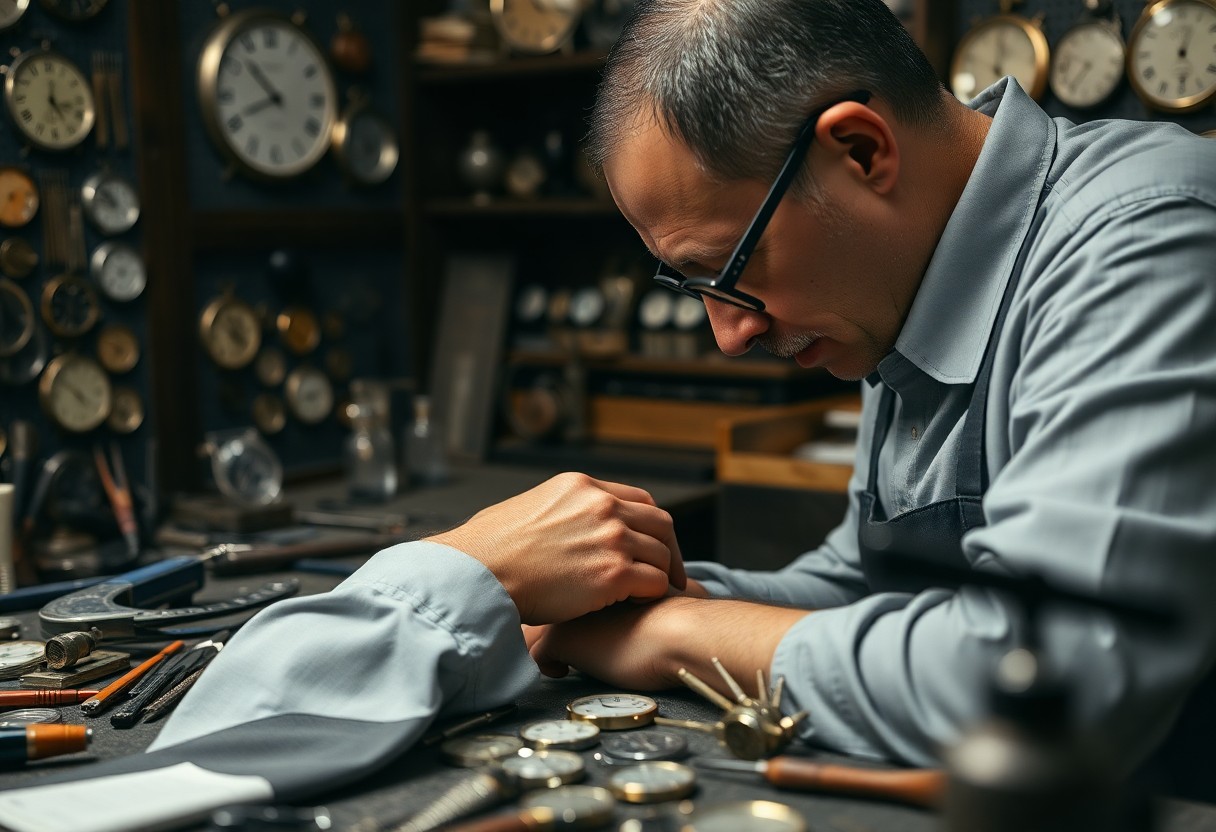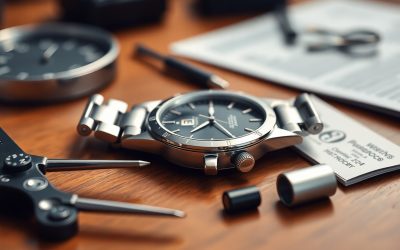There’s a deep satisfaction in breathing new life into vintage watches, and this guide will equip you with necessary knowledge for successful restoration in Atlanta. You’ll discover expert tips on sourcing parts, the best tools to use, and common mistakes to avoid during the restoration process. This journey not only enhances your watch collection but also preserves the rich history behind each timepiece. Get ready to refine your skills and cherish your restored watches for years to come!
Key Takeaways:
- Research History: Understand the watch’s background, including its manufacturer and model details, to appreciate its significance and proper restoration techniques.
- Use Quality Parts: Source genuine or high-quality replacement components to maintain the authenticity and value of the vintage watch during restoration.
- Seek Professional Help: Consider consulting with or hiring vintage watch specialists in Atlanta for complex repairs to ensure optimal results and preservation.
Understanding Vintage Watches
As a watch enthusiast, you might find vintage watches captivating due to their rich history and unique character. Each timepiece carries a story reflective of its era, making them not just accessories but treasured collectibles. Owning such a watch connects you to the craftsmanship of the past while adding a sophisticated touch to your collection.
Key Features of Vintage Timepieces
The key features of vintage watches make them stand out from modern counterparts, showcasing their timeless appeal:
- Mechanical Movements: Often powered by hand-wound or automatic mechanisms.
- Distinctive Design: Features unique shapes, dials, and materials.
- Patina: Natural aging that adds character and charm.
- Limited Production: Often produced in smaller quantities, increasing their rarity.
- Historical Significance: Represents specific eras or events in watchmaking history.
Any serious collector values these features, as they contribute to the overall uniqueness and allure of a vintage timepiece.
Importance of Authenticity
Any collector understands that authenticity is paramount when it comes to vintage watches. An authentic watch not only holds its value better but also ensures you appreciate its true craftsmanship and history.
Timepieces that lack authenticity can lead to significant consequences, including loss of value and the potential for being misled. You must be vigilant, as counterfeit watches may look similar but often show inferior craftsmanship and mechanical issues. Owning an authentic vintage watch provides a level of confidence and pride while ensuring that your collection reflects the true essence of watchmaking artistry. Always seek documentation or expert opinions to confirm the watch’s authenticity, safeguarding your investment and enriching your appreciation of these remarkable pieces.

Factors to Consider Before Restoration
It’s important to evaluate various factors prior to undertaking the restoration of your vintage watch. Consider the following:
- Age and model of the watch
- Type of materials used
- Your budget for restoration
- Sentimental or financial value
Perceiving these aspects will help you make informed decisions about the restoration process.
Condition Assessment
One of the first steps in the restoration process is assessing the condition of your vintage watch. You’ll need to examine the watch for any signs of wear and damage, including the movement, case, and dial. This analysis will guide you in determining what repairs are necessary and how much you should invest in the restoration.
Historical Value
Assessment of a watch’s historical value is vital before proceeding with any restoration work. You need to determine whether the watch holds significant cultural or monetary significance, as this may affect the restoration approach you choose.
It’s important to recognize that restoring a watch with a high historical value could diminish its worth if not done properly. Vintage watches associated with notable events, brands, or limited editions often carry additional meaning for collectors. Thus, before you start restoration, properly involving experts may preserve the watch’s integrity and value.
Gathering the Right Tools
Despite the excitement of restoring a vintage watch, having the right tools is important for success. Start by checking resources like TOP 10 BEST Vintage Watch Repair in Atlanta, GA to find local suppliers that offer quality watch repair tools. Investing in the right equipment saves you time and enhances the quality of your restoration work.
Essential Tools for Restoration
The primary tools you will need include a screwdriver set, case opening tools, tweezers, and a magnifying glass. These items help you safely and efficiently disassemble your vintage watch. You may also want to consider a watch bracelet holder and a cleaning solution to ensure your restoration is precise and thorough.
Safety Equipment
On your journey to restore vintage watches, safety equipment shouldn’t be overlooked. Utilizing protective glasses and gloves not only keeps you safe but also minimizes the risk of damaging delicate components. Make sure to invest in a proper work mat to prevent any tools from slipping or causing injuries while you work.
Essential safety measures can dramatically improve your watch restoration experience. Wearing protective eyewear is vital to shield your eyes from small debris and dust. Additionally, utilizing anti-static gloves will help you handle delicate parts without risking damage. Prioritize a clean work environment, as it reduces the chances of accidents and promotes focus, allowing you to enjoy the process of bringing your vintage watch back to life.

Step-by-Step Restoration Process
Not all vintage watches require the same restoration approach, but following a well-structured process can make your efforts more effective. Below is a simplified breakdown of the vital steps you should follow for a successful restoration:
| Step | Description |
|---|---|
| 1. Disassemble | Carefully take apart the watch components. |
| 2. Clean | Utilize appropriate cleaning methods for each part. |
| 3. Repair/Replace | Fix or swap out any damaged elements. |
| 4. Reassemble | Put the watch back together meticulously. |
| 5. Test | Ensure the watch is functioning correctly. |
Disassembling the Watch
Some vintage watches may have delicate mechanisms, so you should disassemble the watch with caution. Start by using the appropriate tools to remove the case back, ensuring you follow the manufacturer’s guidelines as these can vary. Keep track of smaller parts to avoid losing them during this process.
Cleaning the Components
Any restoration process hinges on the cleaning phase, as it removes grime and ensures all components function smoothly. Use specialized cleaning solutions that are safe for watch parts, as improper methods can lead to damage or corrosion.
StepbyStep cleaning enhances the longevity of your watch. Start by inspecting each component for dirt or oil, then soak them in a designated cleaning solution. Afterward, rinse them gently and let them dry completely. Pay special attention to lubricating parts after cleaning; this step ensures a smooth operation.
Repairing or Replacing Parts
One of the most significant phases of the restoration process involves evaluating which parts require repair or replacement. Some components may be damaged beyond reasonable repair, calling for replacements to ensure your watch’s functionality and reliability.
Repairing parts effectively can save you money and retain the watch’s authenticity. However, if a component is too corroded or broken, you’ll need to seek high-quality replacements sourced from reputable dealers. Always ensure that any replacements match the original specifications to maintain the watch’s integrity.

Reassembly and Testing
Once again, precision is key during the reassembly phase of your vintage watch restoration. Ensure that all components fit together snugly and that no parts are forced into place. Take your time to refer back to your notes or photographs from the disassembly process, as this will guide you in correctly positioning each part. As you reassemble, keep in mind that any misalignment can affect the watch’s performance and longevity.
Proper Reassembly Techniques
There’s an art to reassembling vintage watches, and meticulous attention to detail is necessary. Start by organizing your parts and tools in a clean workspace. Use the correct tools for each component, ensuring that you avoid any damage. As you work, apply a light touch when securing screws and other fasteners to prevent stripping or breakage.
Testing for Accuracy
For testing your vintage watch’s accuracy, set it in a controlled environment to monitor its timekeeping over several days. A watch that keeps time within a few seconds per day is considered to be functioning well. You can use a timegrapher, a specialized device that measures the watch’s rate of gain or loss, to obtain more precise data.
A timegrapher provides vital insights into your watch’s performance, allowing you to make necessary adjustments to the escapement or regulation mechanisms if needed. By observing fluctuations in its timekeeping, you can identify patterns that indicate potential issues. If your watch shows significant deviations, consider consulting a professional watchmaker to ensure your restoration efforts lead to a reliable timepiece that you can cherish for years to come.
Caring for Restored Vintage Watches
Keep your restored vintage watch in optimal condition by applying proper care and maintenance practices. A little attention will ensure your timepiece remains both functional and beautiful for years to come.
Maintenance Tips
On a regular basis, follow these simple yet effective maintenance tips to prolong the lifespan of your restored vintage watch:
- Get your watch professionally serviced every few years to monitor its mechanism.
- Clean the watch case and band with a soft cloth to avoid scratches.
- Keep the watch away from magnets to prevent interference.
- Avoid extreme temperatures that could damage the materials.
Any investment in maintenance enhances the value of your collectible timepiece.
Storage Recommendations
On selecting the right storage solutions, consider the environment where you’ll keep your vintage watch. Protecting it from damage is necessary for preserving its functionality and aesthetics.
For instance, use a watch box with a soft lining to avoid scratches on the surface. Avoid leaving your vintage watch in direct sunlight or extreme humidity, as this can deteriorate the materials. Additionally, storing it in a cool, dry place will help preserve its mechanism and overall integrity. Always place your watch in a secure location to protect it from accidental bumps or drops; keeping it safe is key to maintaining your treasured timepiece.
Summing up
With this in mind, restoring vintage watches in Atlanta can be a rewarding experience for you, allowing you to preserve history and craftsmanship. By understanding the importance of proper techniques, sourcing quality parts, and seeking expert help when needed, you can achieve impressive results. Whether you’re a seasoned collector or a newcomer, it’s beneficial to learn from resources such as Our History – The Antique Watch Company to deepen your understanding of vintage timepieces and enhance your restoration journey.
FAQ
Q: What are the first steps to assess the condition of a vintage watch before restoration?
A: Begin by examining the watch for any visible damage, such as scratches on the crystal or rust on the casing. Take note of the working condition by winding the watch and checking if it keeps time accurately. It’s also helpful to research the specific model to identify parts that may need special attention. Documenting the watch’s condition with photographs can be useful for reference throughout the restoration process.
Q: How do I find a reputable professional for vintage watch restoration in Atlanta?
A: Start by seeking recommendations from watch enthusiasts or collectors in Atlanta. Visiting local watch shops or forums online can also provide insights into reputable restorers. Look for professionals who specialize in vintage watches and have positive reviews. It’s beneficial to ask about their experience, techniques, and whether they offer a warranty on their work to ensure quality restoration.
Q: What factors can influence the cost of restoring a vintage watch?
A: The cost can vary significantly based on several factors, including the complexity of the restoration, the watch’s brand and rarity, and the specific services needed, such as cleaning, part replacement, or polishing. Additionally, sourcing original replacement parts can add to the expense. Getting an estimate before proceeding with the restoration can help you understand the potential costs involved.



